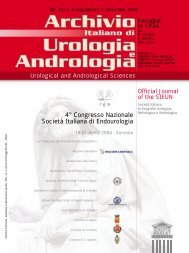7° Congresso Nazionale
7° Congresso Nazionale
7° Congresso Nazionale
You also want an ePaper? Increase the reach of your titles
YUMPU automatically turns print PDFs into web optimized ePapers that Google loves.
<strong>7°</strong> <strong>Congresso</strong> <strong>Nazionale</strong> Associazione Italiana di Endourologia<br />
Minimally invasive treatments for LUTS related to BPH:<br />
an update.<br />
Summary<br />
D. Prezioso, R. Galasso, G. Iapicca, E. Annunziata, F. Iacono<br />
Department of Urology, “Federico II” University of Naples<br />
Objective: The aim of our review is to provide updated information regarding the role<br />
of minimally invasive endourological techniques to treat lower urinary tract symptoms<br />
(LUTS) due to benign prostatic hyperplasia (BPH). We reviewed the literature and the<br />
BPH guidelines, focusing the attenction on randomized controlled trials with significant<br />
number of patients and long-term follow up series. We have considered a large<br />
number of parameters related to minimally invasive interventions, such as the short- and longterm<br />
outcome, complications, morbidity, need for anaesthesia, also comparing the current data<br />
regarding the trans-urethral resection of prostate (TURP).<br />
Results: The minimally invasive therapies can be divided into: thermal-based tehrapies, laser<br />
therapies, ablative therapies and other technologies. They represent a good alternative to<br />
TURP, with interesting results regarding their efficacy and tolerability. The most attractive<br />
treatments are high-energy trans-urethral microwave thermotherapy (TUMT), holmium-laser<br />
resection/enucleation (HoLRP/HoLEP), bipolar trans-urethral resection in saline (TURIS) and<br />
transurethral electrovaporization (TUVP). However, also other new interventions show a good<br />
safety profile and low economical costs.<br />
Conclusions: Today, minimally invasive treatments are a good alternative to traditional TURP,<br />
but prospective, long-term randomized trials are need to evaluate the real outcome.<br />
KEY WORDS: Minimally invasive treatments; Trans-urethral microwave thermotherapy;<br />
Holmium-laser resection/enucleation; Bipolar trans-urethral resection in saline;<br />
Transurethral electrovaporization, Trans-urethral needle ablation.<br />
INTRODUCTION<br />
For a long period of time, transurethral resection of the<br />
prostate (TURP) was considered the “gold standard” surgical<br />
therapy for patients with LUTS related to BPH (1),<br />
associated with significant efficacy (2), but also with<br />
severe morbidity (3-6).<br />
New surgical and minimally invasive treatments show a<br />
comparable efficacy to TURP, with better safety and<br />
lower costs, in terms of quality of life and time of hospitalization.<br />
Aim of this review is to provide updated information<br />
about the role of minimally invasive therapies, analyzing<br />
the evidence-based data of randomized clinical trials and<br />
the recommendations of BPH guidelines (7,8). We<br />
reviewed the literature and the BPH guidelines, focusing<br />
the attenction on randomized controlled trials with significant<br />
number of patients and long-term follow up<br />
series. We have considered a large number of parameters<br />
related to minimally invasive interventions, such as the<br />
short- and long-term outcome, complications, morbidity,<br />
need for anaesthesia, also comparing the current data<br />
regarding the trans-urethral resection of prostate<br />
(TURP).<br />
TRANS-URETHRAL MICROWAVE THERMOTHERAPY (TUMT)<br />
Thermotherapy uses high temperatures to produce coagulation<br />
necrosis of prostatic tissue. Microwaves delivered<br />
via the transurethral route have been the dominant<br />
means used to heat prostatic tissue. TUMT uses a special<br />
transurethral catheter with a microwave antenna that<br />
transmits heat into the prostate with the eventual goal of<br />
destroying tissue by achieving temperatures that exceed<br />
the cytotoxic threshold and inducing cell death. More<br />
specifically, heating in excess of 45°C results in coagulation<br />
necrosis. In addition, apoptosis has been observed,<br />
at temperatures lower than those inducing necrosis.<br />
Recently, it was demonstrated that TUMT increased the<br />
sensory threshold (evoked by electrical stimulation) in<br />
the posterior urethra by 30%, resulting in the alleviation<br />
of storage symptoms (9). During the last decade, numerous<br />
studies have been published presenting the clinical<br />
results from the application of TUMT for the treatment of<br />
LUTS associated with BPH. Many TUMT devices with<br />
different technical specifications and treatment protocols<br />
have been evaluated. Bolmsjo et al (10) reported substantial<br />
differences in heating profiles between devices<br />
with different microwave antenna designs. However, at<br />
Archivio Italiano di Urologia e Andrologia 2007, 79, 3, Supplemento 1<br />
47



